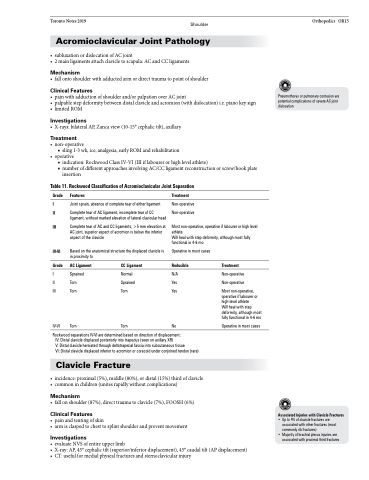Page 949 - TNFlipTest
P. 949
Toronto Notes 2019 Shoulder Acromioclavicular Joint Pathology
• subluxationordislocationofACjoint
• 2mainligamentsattachclavicletoscapula:ACandCCligaments
Mechanism
• fallontoshoulderwithadductedarmordirecttraumatopointofshoulder
Clinical Features
• painwithadductionofshoulderand/orpalpationoverACjoint
• palpablestepdeformitybetweendistalclavicleandacromion(withdislocation)i.e.pianokeysign • limitedROM
Investigations
• X-rays:bilateralAP,Zancaview(10-15°cephalictilt),axillary
Treatment
• non-operative
■ sling 1-3 wk, ice, analgesia, early ROM and rehabilitation
• operative
■ indication: Rockwood Class IV-VI (III if labourer or high level athlete)
■ number of different approaches involving AC/CC ligament reconstruction or screw/hook plate
insertion
Table 11. Rockwood Classification of Acromioclavicular Joint Separation
Orthopedics OR15
Pneumothorax or pulmonary contusion are potential complications of severe AC joint dislocation
Grade Features
I Joint sprain, absence of complete tear of either ligament
II Complete tear of AC ligament, incomplete tear of CC
ligament, without marked elevation of lateral clavicular head
III Complete tear of AC and CC ligaments, >5 mm elevation at AC joint, superior aspect of acromion is below the inferior aspect of the clavicle
Treatment
Non-operative Non-operative
Most non-operative, operative if labourer or high level athlete
Will heal with step deformity, although most fully functional in 4-6 mo
IV-VI Based on the anatomical structure the displaced clavicle is Operative in most cases in proximity to
Grade AC Ligament
I Sprained
II Torn
III Torn
IV-VI Torn
CC Ligament Reducible
Normal N/A Sprained Yes Torn Yes
Torn No
Treatment
Non-operative Non-operative
Most non-operative, operative if labourer or high-level athlete
Will heal with step deformity, although most fully functional in 4-6 mo
Operative in most cases
Rockwood separations IV-VI are determined based on direction of displacement:
IV: Distal clavicle displaced posteriorly into trapezius (seen on axillary XR)
V: Distal clavicle herniated through deltotrapezial fascia into subcutaneous tissue
VI: Distal clavicle displaced inferior to acromion or coracoid under conjoined tendon (rare)
Clavicle Fracture
• incidence:proximal(5%),middle(80%),ordistal(15%)thirdofclavicle • commoninchildren(unitesrapidlywithoutcomplications)
Mechanism
• fallonshoulder(87%),directtraumatoclavicle(7%),FOOSH(6%)
Clinical Features
• painandtentingofskin
• armisclaspedtochesttosplintshoulderandpreventmovement
Investigations
Associated Injuries with Clavicle Fractures
• Up to 9% of clavicle fractures are associated with other fractures (most commonly rib fractures)
• Majority of brachial plexus injuries are associated with proximal third fractures
• evaluateNVSofentireupperlimb
• X-ray:AP,45°cephalictilt(superior/inferiordisplacement),45°caudaltilt(APdisplacement) • CT:usefulformedialphysealfracturesandsternoclavicularinjury


